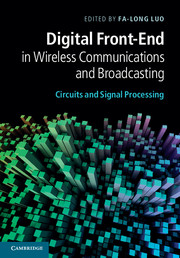Book contents
- Frontmatter
- Contents
- Contributors
- Preface
- Part I Introduction to digital front-end
- Part II DPD and CFR
- 6 General principles and design overview of digital predistortion
- 7 Power amplifier nonlinear modeling for digital predistortion
- 8 Look-up table based digital predistortion schemes and implementation
- 9 Digital predistortion and its combination with crest factor reduction
- 10 Adaptive digital baseband predistortion
- 11 Crest factor reduction techniques
- Part III DUC, DDC, ADC, DAC, and NCO
- Part IV Digital calibration, imbalance compensation, and error corrections
- Part V Circuits and system integration in digital front-end
- Index
- References
11 - Crest factor reduction techniques
from Part II - DPD and CFR
Published online by Cambridge University Press: 07 October 2011
- Frontmatter
- Contents
- Contributors
- Preface
- Part I Introduction to digital front-end
- Part II DPD and CFR
- 6 General principles and design overview of digital predistortion
- 7 Power amplifier nonlinear modeling for digital predistortion
- 8 Look-up table based digital predistortion schemes and implementation
- 9 Digital predistortion and its combination with crest factor reduction
- 10 Adaptive digital baseband predistortion
- 11 Crest factor reduction techniques
- Part III DUC, DDC, ADC, DAC, and NCO
- Part IV Digital calibration, imbalance compensation, and error corrections
- Part V Circuits and system integration in digital front-end
- Index
- References
Summary
Introduction
Signal-to-noise ratio (SNR) is the principal figure of merit for any electronic system. The relation between the signal power and the noise power has been the main challenge for electronic engineers.
In order to study and optimize this type of system, the system design engineers have looked mainly to the noise optimization, that is, to the minimization of all sorts of noise in communication systems. This noise arises mainly from thermal noise [1], nonlinear distortion noise [2], and/or quantization noise in digital systems [3].
Thus the correct identification of the noise contributions is of fundamental importance to the calculation of the noise budget. This is one of the reasons why most of the communication engineers start by worrying about the time domain waveform characteristics of electronic systems. Mainly what they have called the peak of the signal versus its average value, or what is normally known as the peak-to-average ratio (PAR) [4] or crest factor (CF) [5].
- Type
- Chapter
- Information
- Digital Front-End in Wireless Communications and BroadcastingCircuits and Signal Processing, pp. 309 - 330Publisher: Cambridge University PressPrint publication year: 2011
References
- 1
- Cited by



